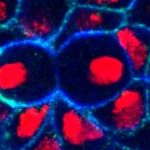Lien vers Pubmed [PMID] – 28041907
Lien DOI – 10.1016/j.devcel.2016.12.004
Dev Cell 2017 Jan; 40(2): 168-184
During epithelial-to-mesenchymal transition (EMT), cells lining the tissue periphery break up their cohesion to migrate within the tissue. This dramatic reorganization involves a poorly characterized reorientation of the apicobasal polarity of static epithelial cells into the front-rear polarity of migrating mesenchymal cells. To investigate the spatial coordination of intracellular reorganization with morphological changes, we monitored centrosome positioning during EMT in vivo, in developing mouse embryos and mammary gland, and in vitro, in cultured 3D cell aggregates and micropatterned cell doublets. In all conditions, centrosomes moved from their off-centered position next to intercellular junctions toward extracellular matrix adhesions on the opposite side of the nucleus, resulting in an effective internal polarity reversal. This move appeared to be supported by controlled microtubule network disassembly. Sequential release of cell confinement using dynamic micropatterns, and modulation of microtubule dynamics, confirmed that centrosome repositioning was responsible for further cell disengagement and scattering.

